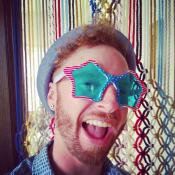All month long, buddies is hosting a blog salon with some our favourite writers and artists responding to one question: How do I connect with my queer heritage? Follow the conversation on our blog, or join the conversation on Facebook and Twitter with the hashtag #GayHeritageProject. Here’s an entry from the charming OCADU professor and artist, Zach Pearl.
The ordinary boys,
happy knowing nothing,
happy being no one, but themselves…
—Morrissey, “Ordinary Boys” (1988)
It’s probably the most ironic thing about me—how I connect with queer culture past and present. I’ve been an incredibly visual person since birth; even drawing before I could talk according to some family members. But I’ve never really been interested in creating or charting specifically queer imagery. My connection to some sense of gay and lesbian heritage has always been felt through music and dance. Through the body, through making sound and movement, music has always spoken more to my sexuality and the continual fluctuation of my identity.
I think that being a child of the 80s exposed me to a critical, experimental time in musical history where ideas of gender, identity and desire were really being pushed to the fore but were still incredibly layered and coded. Artists like Morrissey, even when he was with the Smiths, perfected the art of making music about homosexuality and queer sensibilities without being explicit. And, although it wasn’t the most culturally progressive behaviour, this kind of double-talk carried power in its ability to ‘pass’ in mainstream music while carving out a brand of sacred space for queer knowledge.
In “This Charming Man” (1983), when Morrissey sings He said “return the ring”/He knows so much about these things it invokes an archetypal scene—that of the young, confused homosexual and the wise, charismatic old gay who knows better than to give in to tradition. This ‘homo Solomon’ purports his know-how to avoid normativity. He knows “these things”, which, while remaining ambiguous lyrically, acts as a coded expression for all that’s outside convention. This level of metaphor and nuance created a whole politic behind the music of that era that only resonated with those who really knew to look for it in the first place. David Bowie was also an obvious figurehead for visible alterity and new imaginings of male sexuality. His legendary lyric to turn and face the strange in “Changes” was not only a generational rallying cry but also a gender bomb thrown at the status quo.
Beyond childhood, and particularly through my teenage years, I continued to anchor myself to 80s new wave and post punk bands—Joy Division/New Order, Psychedelic Furs, Gary Numan and Tubeway Army—musicians that were not necessarily homosexual but still made a kind of queer music. This style of music effectively mirrored my misanthropy and psychic anxiety that were responses to the hostile, close-minded environment of a small town high school.
The steely sounds of early synthpop and dark wave also worked to quell my feelings of alienation. Bands like Depeche Mode and Erasure functioned like escape hatches for a teenage mind. The audible frustration in their vocals and their epicene lyrics set against icy electronic beats seemed to project a future version of myself that was more comfortable with its femininity, more assured of its image but still vulnerable. Those songs helped me to repurpose my gendered insecurities as a kind of wearable social stigmata. Oh, those precious goth days of yore…
The remarkable thing about this relationship to 80s and early 90s queer music is that this audial aesthetic has survived well into today, growing evermore honest and inspired. Artists like Baths, Owen Pallett and Diamond Rings are openly gay and making music that still focuses on alienation and inner turmoil resultant of being queer within a heterosexual matrix, but the opacity is gone. The music is full-frontal about these issues. Their candidness is evidence of a lineage of queer musicians fighting for transparency over decades of crafting innuendos and metaphors. When Baths’ Will Wiesenfeld sings he’s lodged in the rectal wall of agony from last year’s “No Past Lives” it’s clearly not the double-talk of the 1980s gay music community. But, the abrasive nature of such a line still works to promote a specifically queer musical language, expressing lack and desire in intensely homoerotic, bodily terms.
Overall, the feeling of heritage comes from being able to see the metaphysical distance travelled through the work of these musicians and a passing of the torch. Queer music has moved from the age of glossy concealing to the age of in-your-face queerness revealing. The lipstick-smeared aggro-sadness of the Cure’s Robert Smith is now the genderbending persona of Placebo frontman Brian Molko. The loveable piano dandy, whose shoes were once filled by Elton John, is now the orchestra-backed chanteur Rufus Wainwright or the electrified honky-tonk of Jake Shears and the Scissor Sisters. These changes are not coincidental. They’re an evolution of the queer creative voice.
When the question is posed, “How do I connect with my queer heritage?” my answer is indubitably another question: “What kind of gay would I be if I didn’t have music on my side?”

